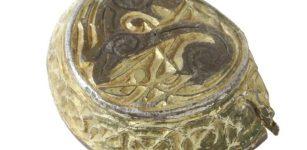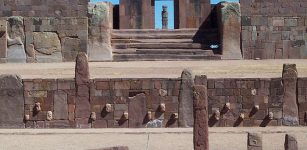Neith – Fearsome Egyptian Mother Of The Gods – Creator Of Sun God Ra, His Archenemy Serpent God Apophis And The Universe
Ellen Lloyd - AncientPages.com - One of the most interesting deities in ancient Egypt is undoubtedly the goddess Neith.
Her unique, complex personality and important responsibilities are the reason why knowledge of her has survived since the Pre-Dynastic Period (c. 6,000-3,150 B.C) when the worship of her started.
Left: Egyptian war goddess Neith wearing the Deshret crown of northern (lower) Egypt, which bears the cobra of Wadjet. Credit: Kkhemet - CC BY-SA 4.0; Right: Ruins of the ancient city of Sais. Drawing from German expedition 1842-1845. Credit: Lepsius-Projekt - Public Domain
Although many early myths of this powerful goddess are lost, we still possess valuable evidence showing her importance in ancient Egypt. From ancient texts and depictions, it’s possible to gain a good understanding of her role in the Land of the Pyramids, but there are still certain aspects of Neith that are shrouded in mystery.
Neith Was One Oldest And Most Important Goddesses Of Lower Egypt
Goddess Neith was the patron of Sais, a beautiful, very old city that existed in the western Egyptian delta along the Rosetta branch of the Nile River. The temple of Neith in Sais was occasionally called the Temple of the Bee. Some scholars have suggested the cult of Neith in Sais was established by Pharaoh Hor-Aha, who according to ancient Egyptian high priest, Manetho learned Egyptians to worship the gods in a proper fashion and to live in a more civilized manner.
As Ancient Pages mentioned earlier, the history of Sais goes back to Egypt’s Pre-Dynastic times (prior to 3,100 B.C).
Many Egyptologists and historians have suggested that Neith was undoubtedly one of the most important goddesses of Lower Egypt. She was frequently represented wearing the Red Crown of Lower Egypt.
Her connection to Lower Egypt is also confirmed in the Pyramid Texts in which it is written – “May the terror of you come into being… like the Net [Neith]- a crown which is on the King of Lower Egypt.” (PT 724)
Neith Created The Universe, Gods And Humans
According to ancient Egyptian records, Neith was the first and the prime creator. She created the Universe and she is often called "Grandmother of the Gods" or "Mother of the Gods".
However, Neith was not only a creator goddess. She was also associated with warfare and hunting and her emblems consisted of crossed arrows and bows. This is also why she was sometimes referred to as “Mistress of the Bow and “Ruler of Arrows”. As a war goddess, Neith manufactured weapons for warriors and she guarded their bodies when they died. During the Old Kingdom, Neith could appear as a manifestation of the Eye of Ra.
Bronze statuette of Neith, wearing the Red Crown of Lower Egypt; the hieroglyphic inscriptions, partially erased, mention the name of Padihor - Egypt, Late Period, The British Museum, London - CC BY-SA 4.0
In ancient Egyptian mythology, the Eye of Ra, is a feminine counterpart to the Sun God Ra and a violent force that subdues his enemies. As many readers of Ancient Pages may know, from our article that explains the meaning of several ancient Egyptian symbols, the eye “ is often seen as an amulet in the form of "wedjat-eye". In the Pyramid Texts two “evil eyes” are mentioned, which seal the door-catch.”
An interesting aspect dealing with Neith’s divine duties is her role as a wise counselor. From the Contendings of Horus and Seth, a mythological story from the twentieth dynasty of ancient Egypt, we learn that Neith’s wisdom was a great asset to other gods. She was so wise that even Sun God Ra, the King of the Gods appealed to her for help.
Birth Of Apophis And Fear Of Apocalypse
A curious inscription dating to Roman times has been found in the temple of Khnum at Esna. This intriguing, text informs us that Neith emerged from the primeval waters to create the world before traveling northward to establish her Delta city of Sais. From the same texts, we also learn that goddess Neith created both Sun God Ra and his archenemy Apophis. As mentioned in our earlier article, “Apophis (also known as Apep) symbolized chaos and powers of darkness. This huge and evil snake was feared by the ancient Egyptians who believed that Apocalypse could be brought about by him.”
Ancient Egyptian records reveal the Neith was the eldest, mother of the gods who illuminated the first face. Due to her warlike nature, ancient Greeks made several attempts to identify Neith with Athena, but ancient records do not provide sufficient evidence to state these were the same goddesses.
Neith is also the guardian goddess over Duamutef, one of the Four Sons of Horus who watch over the canopic jars in the tombs. Her power was without ending, or so it seems. She is also said to be the judge of the dead in the Hall of Truth.
In some depictions, we can see the goddess Neith nursing a baby crocodile. She is called the "Nurse of Crocodiles", and it has been suggested that she was the mother of Sobek, an enigmatic crocodile God of ancient Egypt.
Written by Ellen Lloyd – AncientPages.com
Updated on July 17, 2021
Copyright © AncientPages.com All rights reserved. This material may not be published, broadcast, rewritten or redistributed in whole or part without the express written permission of AncientPages.com
Expand for referencesBunson, M. - The Encyclopedia of Ancient Egypt
More From Ancient Pages
-
 Yew: Mysterious Ominous And Sacred Tree Revered By Our Ancestors Since The Dawn Of Civilization
Featured Stories | Feb 8, 2022
Yew: Mysterious Ominous And Sacred Tree Revered By Our Ancestors Since The Dawn Of Civilization
Featured Stories | Feb 8, 2022 -
 Anchor Church Caves – Has The Home Of Anglo-Saxon King Eardwulf And Saint Hardulph Been Found?
Archaeology | Jul 23, 2021
Anchor Church Caves – Has The Home Of Anglo-Saxon King Eardwulf And Saint Hardulph Been Found?
Archaeology | Jul 23, 2021 -
 Akhenaten: Unorthodox Ruler Who Had Only One God
Featured Stories | Mar 28, 2017
Akhenaten: Unorthodox Ruler Who Had Only One God
Featured Stories | Mar 28, 2017 -
 Strange 1,200-Year-Old Anglo-Saxon Artifact Used For Unknown Purpose Found In Norfolk, UK
Archaeology | Jan 18, 2024
Strange 1,200-Year-Old Anglo-Saxon Artifact Used For Unknown Purpose Found In Norfolk, UK
Archaeology | Jan 18, 2024 -
 Superfood Of Ancient Andeans Reconstructed – What Helped To Fuel The Tiwanaku Civilization 2,500 Years?
Archaeology | Nov 30, 2021
Superfood Of Ancient Andeans Reconstructed – What Helped To Fuel The Tiwanaku Civilization 2,500 Years?
Archaeology | Nov 30, 2021 -
 Land of Israel: A 5,000-Year-Old Settlement And A Pottery Kiln Unearthed Near Beit Shemesh At The Site Of Hurvat Husham
Archaeology | Oct 30, 2024
Land of Israel: A 5,000-Year-Old Settlement And A Pottery Kiln Unearthed Near Beit Shemesh At The Site Of Hurvat Husham
Archaeology | Oct 30, 2024 -
 The Enigma Of People And Gods With Horns In Ancient Times
Ancient Mysteries | Nov 7, 2015
The Enigma Of People And Gods With Horns In Ancient Times
Ancient Mysteries | Nov 7, 2015 -
 Mystery Of The 2,000-Year-Old Grave On The Isles Of Scilly Solved!
Archaeology | Jul 28, 2023
Mystery Of The 2,000-Year-Old Grave On The Isles Of Scilly Solved!
Archaeology | Jul 28, 2023 -
 Pazzi Conspiracy – Failed Murder Attempt On Lorenzo de’ Medici Made Him Even More Powerful And Threw Renaissance Florence Into Chaos
Featured Stories | Feb 14, 2025
Pazzi Conspiracy – Failed Murder Attempt On Lorenzo de’ Medici Made Him Even More Powerful And Threw Renaissance Florence Into Chaos
Featured Stories | Feb 14, 2025 -
 Beautiful Ancient City Of Pisac In The Sacred Valley, Peru – Incredible Inca Ruins
Featured Stories | Jun 22, 2017
Beautiful Ancient City Of Pisac In The Sacred Valley, Peru – Incredible Inca Ruins
Featured Stories | Jun 22, 2017 -
 Roman Tombs Unearthed In Egypt’s Dakhla Oasis
Archaeology | Jan 28, 2019
Roman Tombs Unearthed In Egypt’s Dakhla Oasis
Archaeology | Jan 28, 2019 -
 Priceless 800-Year-Old Treasure Featuring Three Golden Lions Unearthed
Archaeology | Aug 5, 2022
Priceless 800-Year-Old Treasure Featuring Three Golden Lions Unearthed
Archaeology | Aug 5, 2022 -
 DNA Evidence Ice Age Humans Migrated From China To The Americas And Japan
DNA | May 9, 2023
DNA Evidence Ice Age Humans Migrated From China To The Americas And Japan
DNA | May 9, 2023 -
 Victory Tower – An Imposing Victory Monument In Chittorgarh, Rajasthan, India
Civilizations | Jul 28, 2015
Victory Tower – An Imposing Victory Monument In Chittorgarh, Rajasthan, India
Civilizations | Jul 28, 2015 -
 World’s Oldest Fairy Tale – The Smith And The Devil Has Survived For Several Millennia
Ancient History Facts | Aug 30, 2017
World’s Oldest Fairy Tale – The Smith And The Devil Has Survived For Several Millennia
Ancient History Facts | Aug 30, 2017 -
 Oldest case of leukemia found on 7,000-Year-old skeleton
News | Aug 23, 2015
Oldest case of leukemia found on 7,000-Year-old skeleton
News | Aug 23, 2015 -
 400-Year-Old Shipwreck Found Off The Coast Of Portugal Labeled ‘Discovery Of A Decade’
Archaeology | Sep 26, 2018
400-Year-Old Shipwreck Found Off The Coast Of Portugal Labeled ‘Discovery Of A Decade’
Archaeology | Sep 26, 2018 -
 15 Prehistoric Rock Paintings Discovered Near Ancient Armenian City Of Ani
Archaeology | Dec 14, 2015
15 Prehistoric Rock Paintings Discovered Near Ancient Armenian City Of Ani
Archaeology | Dec 14, 2015 -
 Ancient City Of Hippos-Sussita And The Mysterious Disc-Shaped Copper Plates
Archaeology | Apr 18, 2017
Ancient City Of Hippos-Sussita And The Mysterious Disc-Shaped Copper Plates
Archaeology | Apr 18, 2017 -
 Rare Ancient Roman Cauldron Discovered In Central Norway
Archaeology | Sep 16, 2019
Rare Ancient Roman Cauldron Discovered In Central Norway
Archaeology | Sep 16, 2019


